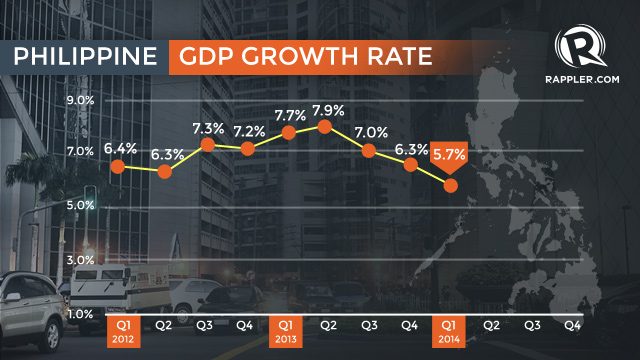SUMMARY
This is AI generated summarization, which may have errors. For context, always refer to the full article.

MANILA, Philippines (2nd UPDATE) – The Philippines’ roaring economy cooled in the first quarter of 2014 as the impact of Super Typhoon Yolanda (Haiyan) and other natural disasters hit harder than expected, the government said Thursday, May 29.
National Statistician Lisa Grace Bersales said growth slowed to 5.7% in January to March from 6.3% in the fourth quarter and 7.7% in the first quarter of last year.
Socioeconomic Planning Secretary Arsenio Balisacan said, “The relatively slow growth is expected given the magnitude of the destruction,” highlighting damage particularly to the agriculture, trade and tourism sectors.
He said damage to agricultural output disrupted supply chains, resulting in the decline in food manufacturing. (READ: Typhoons slows down PH agriculture growth in Q1)
“We were expecting, like so many observers, we would hit the range of 6.5-7.5% if things were not so bad in the disruption of the supply chains,” Balisacan said.
The Philippines has in recent years had one of the fastest-growing economies in Asia, with rising confidence seeing the once regional laggard awarded investment-grade ratings while the stock market hit record highs.
The Philippine economy grew 7.2% last year, the fastest in Asia after China.
However, the country endured a brutal run of natural disasters toward the end of last year that claimed thousands of lives, while severely damaging vital farming, fishing and tourism industries.
The worst disaster was Yolanda, which carried the strongest winds ever recorded on land and killed or left missing more than 7,300 people as it tore across the central Philippines in November.
The previous month, a 7.1-magnitude earthquake killed more than 200 people on the tourist islands of Bohol and Cebu.
Apart from the disasters, Balisacan said prudent lending measures taken by the central bank to prevent the formation of asset bubbles also weighed on first quarter growth. “Private construction was affected by such measures.”
Full-year target achievable
Balisacan nevertheless said the economy remained among the fastest growing in Asia. He said the Philippines’ growth was the third fastest, next to China’s 7.4% and Malaysia’s 6.2%.
He said the main drivers included overseas remittance inflows, resilient IT-BPO and export-oriented manufacturing sectors, as well as household spending and public construction.
He said the economy was expected to return to stronger growth rates by the second quarter.
“We remain confident that we will meet the growth target of 6.5% to 7.5% for the full year 2014.”
Crucial in boosting growth momentum are recovery and reconstruction efforts in disaster-stricken areas and timely implementation of strategies in the Philippine Development Plan, the country’s economic blueprint until 2016. (READ: 6 months after Yolanda: ‘We are failing’)
“We see urgency in speeding up reconstruction efforts… [These] will rebuild assets and restore supply chains.”
He added that the growing energy requirements of the economy must be managed to avert a power crisis.
“With additional capacity forthcoming only in 2015, higher energy prices are expected until such time so measures to cushion the impact on households and businesses should be put in place, keeping in mind that the more costly alternative is to have no power at all.” – Rappler.com, with a report from Agence France-Presse
Add a comment
How does this make you feel?
There are no comments yet. Add your comment to start the conversation.